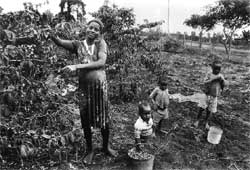Peru
 Despite their long history and their prominence in the local diet, potato yields of small Andean farmers are generally low. This is largely due to pest and disease-related losses. Intensified potato production, less reliance on local species and varieties, and the indiscriminate use of pesticides has resulted in a high incidence of pests and diseases. Early in 1997, Centre for Research and Information on Low-External-Input and Sustainable Agriculture ( ileia) programme in Peru began a ptd process among farmer groups in central and northern parts of the country. The majority of these groups identified potato pests as a major constraint in agricultural production. ileia employed several storage methods to reduce the incidence of these pests. Storing the potatoes in sand, barley straw, quinua chaff saw a gradual decrease in the number of these pest attacks.
Despite their long history and their prominence in the local diet, potato yields of small Andean farmers are generally low. This is largely due to pest and disease-related losses. Intensified potato production, less reliance on local species and varieties, and the indiscriminate use of pesticides has resulted in a high incidence of pests and diseases. Early in 1997, Centre for Research and Information on Low-External-Input and Sustainable Agriculture ( ileia) programme in Peru began a ptd process among farmer groups in central and northern parts of the country. The majority of these groups identified potato pests as a major constraint in agricultural production. ileia employed several storage methods to reduce the incidence of these pests. Storing the potatoes in sand, barley straw, quinua chaff saw a gradual decrease in the number of these pest attacks.
Related Content
- Measures to enhance forest conservation and reduce deforestation: viewpoints and lessons from producing countries
- Leveraging technologies for gender equality in mining communities: case studies from the Democratic Republic of the Congo, South Africa, and Peru
- Natural climate solutions and fire mitigation: early findings on the path to net zero
- The relations between climate change and child labour in agriculture
- Multilateral Development Bank efforts to mainstream climate adaptation: progress from the perspectives of three countries
- Investing in farmers: agriculture human capital investment strategies
